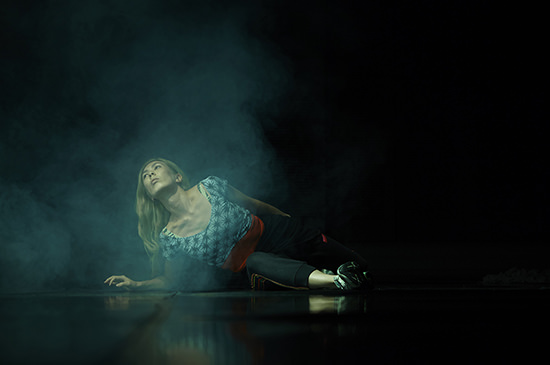 |
Desert Body Creep, Next Wave 2016 photo Zan Wimberley |
Performed by its maker, Angela Goh, Desert Body Creep gives us two shape-shifting protagonists: the female body and an oversized gummi worm. The opening sequences establish Goh in preludial mode, spot-lit and dressed in unremarkable, slightly retro leisurewear, she revolves with a gentle robotic slide, making inchoate arm gestures. Loud vintage-sounding pop and moody light suspend her in a kind of cinematic, soft-focus disco, but after a brief black-out the music changes to a twanging guitar soundtrack and she’s on the floor, looping repeatedly through a carefully decelerated backwards roll.
Enter, worm. Goh crawls towards the audience with an invertebrate sitting casually down the length of her spine (a nice visual pun). From William Blake’s invisible worm that flies in the night, to those in Frankenstein that “inherited the wonders of the eye and the brain,” to Mercutio’s howl in Romeo and Juliet that he will soon be food for worms—this is a powerful signifier that death is in the room. On the other hand, here is a rubbery, very cute, super bouncy-looking and slightly pitiable lolly worm. Are we to be horrified, or charmed? When Goh runs a pole up and down the underbelly of the worm, intermittently animating it with absurd but believable character, she does so with attentiveness. There seems to be profound emotional content in this relationship.
From here Desert Body Creep is in full command of its themes—consumption, mutability, horror and decay are enacted in a series of transformations of Goh’s body. She moves to a microphone and multi-track recorder and after establishing a screeching choir of high notes, wheels slowly backwards in terror, her mouth a petrified O. Once more there’s a strong cinematic feel to the music and the slowness of it all, horror and sci-fi film tropes of invasion, gore and monstrosity are increasingly conjured.
Transformation is a central concern in dance, which is fundamentally a licensed invasion of performers’ bodies by the choreographer; Yvonne Rainer used the word “transmission” to describe the process of transferring movement from one body to another. After handling the worm, Goh becomes one herself, jerking along the floor consuming pieces of fabric, which she then uses to throw cartoonish monster shapes. It’s funny and silly, but the replacement of one body with another, the work of worms, is still discomfiting. Rainer famously pointed out that “dance is hard to see.” Desert Body Creep gives us a plain symbol of the body’s (and therefore dance’s) inevitable decay. It also reminds us that if we are only looking for dance where we expect to find it (in a ‘performing’ body, in a ‘choreographed’ body) it’s hard to see in other movement.
The work is structured around successive, not integrated, scenes. Although Angela Goh seems to undergo a full metamorphosis when she is entirely swallowed by a green velour sheath, there’s no illusion. In fact, here she’s almost at her most human, the outline of her bowed head and shoulder clearly visible as she slides around, vacuuming up the clumps of fabric in her path. When she emerges naked (perhaps new) she unfussedly ties back her hair and drinks from a water bottle. We’re suddenly and awkwardly aware that the work has itself transformed into domestic, potentially private activity. Dance is hard to see.
Un-costumed now, Goh’s body achieves its most complete transformation when a motorised muscle-vibrating platform is put into the service of oscillating her flesh into increasingly intense ripples. The guitars are back and totally wailing, it’s unabashedly comical, yet somehow triumphant. After a while every part of her is jiggling and wobbling; even the folds of her elbows spiral.
There’s a modest denouement when the dancer walks calmly to a piano at the side of the stage and plays a few bars, perhaps a nod to the childhood lessons that are no longer necessary in this transformed desert.
Next Wave Festival 2016: Desert Body Creep, choreographer, performer Angela Goh, sound design Matt Cornell; Northcote Town Hall, Melbourne, 17-22 May
Alison Finn works in criminal law in Melbourne, with particular interests in the law and the philosophy of human dignity, privacy, surveillance and ‘big data.’ She also writes creatively in various forms and continues a contemporary dance practice.
This review was written in the DanceWrite dance reviewing workshop. Read more reviews here.
DanceWrite was conducted by RealTime editors Keith Gallasch and Virginia Baxter with mentors Andrew Fuhrmann and Jana Perkovic. The workshop was an initiative of Hannah Matthews as part of her Australia Council-funded Sharing Space program and was presented in collaboration with Next Wave and RealTime.
RealTime issue #132 April-May 2016
© Alison Finn; for permission to reproduce apply to [email protected]








 back
back